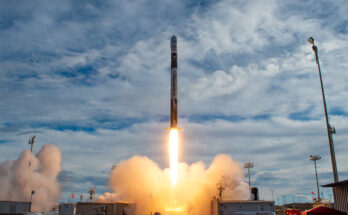by Bill Ostrove, Space Systems Analyst, Forecast International.
 The average size, or launch mass, of commercial communications satellites is declining. After the average launch mass reached a peak of 4,424 kilograms in 2012, it declined to 3,578 kilograms in 2013 and 2,755 kilograms in 2014. Even the launch mass of geosynchronous satellites, which are typically heavier than LEO spacecraft, declined in 2014. The launch mass of GEO satellites peaked in 2013, when it reached 5,288 kilograms. The average launch mass of geosynchronous satellites declined to 4,276 kilograms in 2014.
The average size, or launch mass, of commercial communications satellites is declining. After the average launch mass reached a peak of 4,424 kilograms in 2012, it declined to 3,578 kilograms in 2013 and 2,755 kilograms in 2014. Even the launch mass of geosynchronous satellites, which are typically heavier than LEO spacecraft, declined in 2014. The launch mass of GEO satellites peaked in 2013, when it reached 5,288 kilograms. The average launch mass of geosynchronous satellites declined to 4,276 kilograms in 2014.
The decline in launch mass can be attributed to a number of factors. First, because smaller satellites are cheaper, they tend to be the preference of the smaller regional satellite operators that are gaining in importance in the overall market. In addition, smaller and cheaper launch vehicles like the Falcon 9 are further increasing the appeal of small satellites. In the past, satellite operators relied on the Ariane 5 and Proton to carry spacecraft into orbit. The large size and expense of these vehicles limited their frequency of use. Smaller vehicles like the Falcon 9 can be used more frequently, increasing operational efficiency for satellite operators.
Advances in technology are also making small satellites more appealing. For example, in 2015, Asia Broadcast Satellite and Eutelsat each launched a satellite that uses all-electric propulsion. This technology reduces the need for large stores of propellant and lessens the size requirements of satellites. As these satellites become more popular, the trend toward smaller satellites can be expected to continue.
This trend has compelled many satellite manufacturers that have traditionally specialized in large platforms, such as Boeing, to broaden their product lineup to include smaller satellites. A few years ago Boeing introduced its Boeing-702SP platform – a smaller, more cost-effective variant of its larger 702 satellite.
Also contributing to the trend toward smaller satellites are plans by some companies – such as LeoSat, OneWeb, and SpaceX – to build networks of hundreds of tiny satellites to provide Internet and broadband connections. While these projects have caught the attention of many investors in wealthy Silicon Valley and elsewhere, it remains unclear if these plans will work. In the late 1990s and early 2000s, companies attempted to build similar networks of LEO communications satellites. But their huge expense meant they could not compete with terrestrial broadband networks.
We must caution that there are factors that could reverse the trend toward smaller satellites. The Ariane 5 remains a powerful influence in the market, and a return to reliability of the Proton could further improve the market for heavy launch services. These larger vehicles are able to support more equipment that can provide service to larger numbers of customers. Also, the higher cost and launch capability of large launch vehicles like the Ariane 5 and Proton encourage satellite operators to launch just a few large satellites to reduce the number of launch contracts and maximize launch vehicle capability.
In the overall commercial communications satellite market, between 2010 and 2014, commercial satellite operators took delivery of 153 satellites. Over that timeframe, deliveries peaked in 2014, with the launch of 37 satellites. Deliveries reached the low point in 2012, when only 26 spacecraft were delivered. Going forward, Forecast International expects deliveries to approximate the 2014 figure, being driven by demand for data connectivity, by the growth in television markets in developing countries, and by the desire by many countries to own and operate their own satellites.
For full coverage on this market and its programs, see Forecast International’s Space Systems Forecast.
A military history enthusiast, Richard began at Forecast International as editor of the World Weapons Weekly newsletter. As the Internet grew in importance as a research tool, he helped design the company's Forecast Intelligence Center and currently coordinates the EMarket Alert newsletters for clients. Richard also manages social media efforts, including two new blogs: Defense & Security Monitor, covering defense systems and international issues, and Flight Plan, which focuses on commercial aviation and space systems. For over 30 years, Richard has authored the Defense & Aerospace Companies, Volume I (North America) and Volume II (International) services. The two books provide detailed data on major aerospace and defense contractors. He also edits the International Contractors service, a database that tracks all the contractors involved in the programs covered in the FI library. More recently he was appointed Manager, Information Services Group (ISG), a new unit that encompasses developing outbound content for both Forecast International and Military Periscope.



